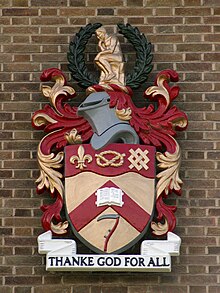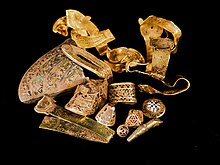| This Wikipedia page has been superseded by Portal:Staffordshire and is retained primarily for historical reference. |
| Note: Article entries are now being transcluded directly on the main portal page. However, this page should be retained for historical reference. |
Selected article 1
Portal:Staffordshire/Selected article/1
The University of Keele, commonly known as "Keele University", is a public research campus university about 3 miles (4.5 km) from Newcastle-under-Lyme, Staffordshire, England. Keele was granted university status by Royal Charter in 1962, and was originally founded in 1949 as the 'University College of North Staffordshire', as an experimental college dedicated to a broad curriculum and interdisciplinary study.
The university occupies a 620 acre (250 ha) rural campus close to the village of Keele and has a science park and a conference centre, making it the largest main campus university in the UK. The university's School of Medicine operates the clinical part of their courses from a separate campus at the University Hospital of North Staffordshire in Hartshill, Stoke-on-Trent. The school of nursing and midwifery is based at the nearby clinical education centre.
Selected article 2
Portal:Staffordshire/Selected article/2
Shugborough Hall is a country house and estate, situated in Great Haywood, Staffordshire. Previously the home of the Earls of Lichfield, it is now owned by the National Trust and maintained by the leaseholder, Staffordshire County Council.
The Shugborough estate was owned by the Bishops of Lichfield until the Dissolution of the Monasteries around 1540 and thereafter passed through several hands until it was purchased in 1624 by William Anson, a lawyer, of Dunston, Staffordshire, and ancestor the Earls of Lichfield. In about 1693 his grandson William Anson (1656–1720) demolished the old house and created a new mansion. The entrance front then to the west, comprised a balustraded three-storey, seven-bayed central block . In about 1748 his great grandson Thomas Anson commissioned architect Thomas Wright to remodel the house, which was extended with flanking two-storey, three-bayed pavilions linked to the central block by pedimented passages. At the turn of the 18th century the house was further altered and extended by architect Samuel Wyatt, when the pavilions and passages were incorporated into the main building and a new porticoed entrance front with ten Doric order pillars was created at the east for Thomas Anson, the 1st Viscount Anson.
Around 1750 the architect James Stuart, created a number of follies and monuments in the grounds. These include the Chinese House, the Triumphal Arch based on Hadrian's and the Doric Temple as well as the Temple of the Winds and Shepherd's Monument and the Cat's Monument.
Selected article 3
Portal:Staffordshire/Selected article/3

The federation of Stoke-on-Trent was the 1910 amalgamation of the six Potteries towns of Burslem, Tunstall, Stoke-upon-Trent, Hanley, Fenton and Longton into the single county borough of Stoke-on-Trent. An anomaly in the history of English local government, this was the first union of its type and the only such event to take place until the 1960s. lists the federation of Stoke-on-Trent as unique, as the publication precedes the recommendations of the Local Government Commission for England (1958–1967). These recommendations created other county boroughs by federation, for example the County Borough of Warley created by the Local Government (West Midlands) Order 1965 (SI 1965 No. 2139) and the County Borough of Teesside created by the Teesside Order 1967 (SI 1967 No. 396).}} The 1910 federation was the culmination of a process of urban growth and municipal change that started in the early 19th century.
The first federation attempt was made in 1900 with a resurrection of the county plan. In 1902, Hanley Council led attempts to form an expanded county borough, but disagreement over the complex financial issues of rates, assets and loans caused Fenton to pull out, quickly followed by Burslem and Stoke, and the proposal was abandoned in 1903. The second and final federation process, between 1905 and 1910, was instigated by Longton Town Council with support from Stoke and Hanley and opposition from Fenton, Tunstall and Burslem. Issues again arose over the financial settlement and discussions continued during the progress of the Federation Bill through Parliament. The bill was passed in the House of Commons and was still under debate in the House of Lords when the six towns announced that they had come to an agreement. Passed in December 1908, the act came into force on 31 March 1910. The new Stoke-on-Trent was a county borough from then until [Local_Government_Act_1972|1974]. In addition, city status was granted to Stoke-on-Trent by King George V on 1 July 1925.
Selected article 4
Portal:Staffordshire/Selected article/4
The Staffordshire Hoard is the largest hoard of Anglo-Saxon gold and silver metalwork yet found[update]. Discovered in a field near the village of Hammerwich, near Lichfield, in Staffordshire, England, on 5 July 2009, it consists of over 3,500 items that are nearly all martial in character and contains no objects specific to female uses. The artefacts have tentatively been dated to the 7th or 8th centuries, placing the origin of the items in the time of the Anglo-Saxon kingdom of Mercia. Experts have produced a range of theories as to where the hoard came from and how it came to be deposited, and whether the objects were made for Christians or pagans. The average quality of the workmanship is extremely high and especially remarkable in view of the large number of individual objects, such as swords or helmets, from which the elements in the hoard came.
The hoard has been described by Leslie Webster, former keeper of the department of prehistory at the British Museum, as "absolutely the metalwork equivalent of finding a new Lindisfarne Gospels or Book of Kells." She stated further that "this is going to alter our perceptions of Anglo-Saxon England as radically, if not more so, as the Sutton Hoo discoveries." Dr Roger Bland, Head of the Portable Antiquities Scheme, said, "It is a fantastically important discovery. It is assumed that the items were buried by their owners at a time of danger with the intention of later coming back and recovering them."
The hoard was valued at £3.285 million and has now been purchased by the Birmingham Museum & Art Gallery and the Potteries Museum & Art Gallery.
Selected article 5
Portal:Staffordshire/Selected article/5
Lichfield Cathedral, in Lichfield, Staffordshire, is the seat of the Bishop of Lichfield and the only cathedral in Staffordshire. The Diocese of Lichfield covers all of Staffordshire, much of Shropshire and part of the Black Country and West Midlands.
The cathedral is dedicated to Saint Chad and Saint Mary and is the only medieval cathedral in England with three spires. Its internal length is 113 metres (370 feet), and the breadth of the nave is 21m (68'). The central spire is 77m (252') high and the western spires are about 58m (190').
Although a cathedral has been on the site since circa 700AD, the present building was not started in 1195. It was completed by the building of the lady chapel in the 1330s. The choir dates from 1200, the transepts from 1220 to 1240 and the nave was started in 1260. The octagonal chapter house, which was completed in 1249 and is one of the most beautiful parts of the Cathedral with some charming stone carvings, houses an exhibition of the cathedral's greatest treasure, the Lichfield Gospels, an 8th-century illuminated manuscript.



